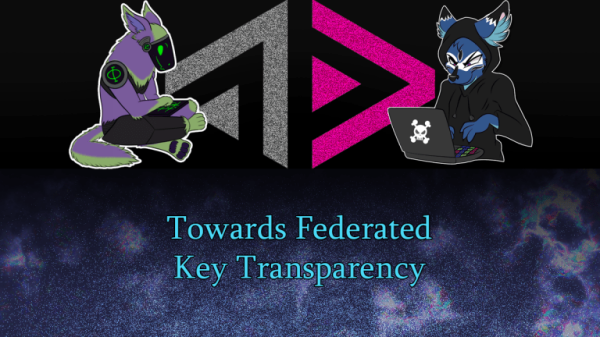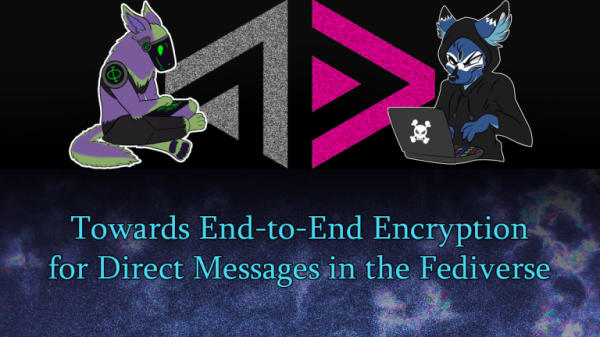Update (2024-06-06): There is an update on this project.
As Twitter’s new management continues to nosedive the platform directly into the ground, many people are migrating to what seem like drop-in alternatives; i.e. Cohost and Mastodon. Some are even considering new platforms that none of us have heard of before (one is called “Hive”).
Needless to say, these are somewhat chaotic times.
One topic that has come up several times in the past few days, to the astonishment of many new Mastodon users, is that Direct Messages between users aren’t end-to-end encrypted.
And while that fact makes Mastodon DMs no less safe than Twitter DMs have been this whole time, there is clearly a lot of value and demand in deploying end-to-end encryption for ActivityPub (the protocol that Mastodon and other Fediverse software uses to communicate).
However, given that Melon Husk apparently wants to hurriedly ship end-to-end encryption (E2EE) in Twitter, in some vain attempt to compete with Signal, I took it upon myself to kickstart the E2EE effort for the Fediverse.
https://twitter.com/elonmusk/status/1519469891455234048
So I’d like to share my thoughts about E2EE, how to design such a system from the ground up, and why the direction Twitter is heading looks to be security theater rather than serious cryptographic engineering.
If you’re not interested in those things, but are interested in what I’m proposing for the Fediverse, head on over to the GitHub repository hosting my work-in-progress proposal draft as I continue to develop it.
How to Quickly Build E2EE
If one were feeling particularly cavalier about your E2EE designs, they could just generate then dump public keys through a server they control, pass between users, and have them encrypt client-side. Over and done. Check that box.
Every public key would be ephemeral and implicitly trusted, and the threat model would mostly be, “I don’t want to deal with law enforcement data requests.”
Hell, I’ve previously written an incremental blog post to teach developers about E2EE that begins with this sort of design. Encrypt first, ratchet second, manage trust relationships on public keys last.
If you’re catering to a slightly tech-savvy audience, you might throw in SHA256(pk1 + pk2) -> hex2dec() and call it a fingerprint / safety number / “conversation key” and not think further about this problem.
Look, technical users can verify out-of-band that they’re not being machine-in-the-middle attacked by our service.An absolute fool who thinks most people will ever do this
From what I’ve gathered, this appears to be the direction that Twitter is going.
https://twitter.com/wongmjane/status/1592831263182028800
Now, if you’re building E2EE into a small hobby app that you developed for fun (say: a World of Warcraft addon for erotic roleplay chat), this is probably good enough.
If you’re building a private messaging feature that is intended to “superset Signal” for hundreds of millions of people, this is woefully inadequate.
https://twitter.com/elonmusk/status/1590426255018848256

If this is, indeed, the direction Musk is pushing what’s left of Twitter’s engineering staff, here is a brief list of problems with what they’re doing.
- Twitter Web. How do you access your E2EE DMs after opening Twitter in your web browser on a desktop computer?
- If you can, how do you know twitter.com isn’t including malicious JavaScript to snarf up your secret keys on behalf of law enforcement or a nation state with a poor human rights record?
- If you can, how are secret keys managed across devices?
- If you use a password to derive a secret key, how do you prevent weak, guessable, or reused passwords from weakening the security of the users’ keys?
- If you cannot, how do users decide which is their primary device? What if that device gets lost, stolen, or damaged?
- Authenticity. How do you reason about the person you’re talking with?
- Forward Secrecy. If your secret key is compromised today, can you recover from this situation? How will your conversation participants reason about your new Conversation Key?
- Multi-Party E2EE. If a user wants to have a three-way E2EE DM with the other members of their long-distance polycule, does Twitter enable that?
- How are media files encrypted in a group setting? If you fuck this up, you end up like Threema.
- Is your group key agreement protocol vulnerable to insider attacks?
- Cryptography Implementations.
- What does the KEM look like? If you’re using ECC, which curve? Is a common library being used in all devices?
- How are you deriving keys? Are you just using the result of an elliptic curve (scalar x point) multiplication directly without hashing first?
- Independent Third-Party Review.
- Who is reviewing your protocol designs?
- Who is reviewing your cryptographic primitives?
- Who is reviewing the code that interacts with E2EE?
- Is there even a penetration test before the feature launches?
As more details about Twitter’s approach to E2EE DMs come out, I’m sure the above list will be expanded with even more questions and concerns.
My hunch is that they’ll reuse liblithium (which uses Curve25519 and Gimli) for Twitter DMs, since the only expert I’m aware of in Musk’s employ is the engineer that developed that library for Tesla Motors. Whether they’ll port it to JavaScript or just compile to WebAssembly is hard to say.
How To Safely Build E2EE
You first need to decompose the E2EE problem into five separate but interconnected problems.
- Client-Side Secret Key Management.
- Multi-device support
- Protect the secret key from being pilfered (i.e. by in-browser JavaScript delivered from the server)
- Public Key Infrastructure and Trust Models.
- TOFU (the SSH model)
- X.509 Certificate Authorities
- Certificate/Key/etc. Transparency
- SigStore
- PGP’s Web Of Trust
- Key Agreement.
- While this is important for 1:1 conversations, it gets combinatorially complex when you start supporting group conversations.
- On-the-Wire Encryption.
- Direct Messages
- Media Attachments
- Abuse-resistance (i.e. message franking for abuse reporting)
- The Construction of the Previous Four.
- The vulnerability of most cryptographic protocols exists in the joinery between the pieces, not the pieces themselves. For example, Matrix.
This might not be obvious to someone who isn’t a cryptography engineer, but each of those five problems is still really hard.
To wit: The latest IETF RFC draft for Message Layer Security, which tackles the Key Agreement problem above, clocks in at 137 pages.
Additionally, the order I specified these problems matters; it represents my opinion of which problem is relatively harder than the others.
When Twitter’s CISO, Lea Kissner, resigned, they lost a cryptography expert who was keenly aware of the relative difficulty of the first problem.
https://twitter.com/LeaKissner/status/1592937764684980224
You may also notice the order largely mirrors my previous guide on the subject, in reverse. This is because teaching a subject, you start with the simplest and most familiar component. When you’re solving problems, you generally want the opposite: Solve the hardest problems first, then work towards the easier ones.
This is precisely what I’m doing with my E2EE proposal for the Fediverse.
The Journey of a Thousand Miles Begins With A First Step
Before you write any code, you need specifications.
Before you write any specifications, you need a threat model.
Before you write any threat models, you need both a clear mental model of the system you’re working with and how the pieces interact, and a list of security goals you want to achieve.
Less obviously, you need a specific list of non-goals for your design: Properties that you will not prioritize. A lot of security engineering involves trade-offs. For example: elliptic curve choice for digital signatures is largely a trade-off between speed, theoretical security, and real-world implementation security.
If you do not clearly specify your non-goals, they still exist implicitly. However, you may find yourself contradicting them as you change your mind over the course of development.
Being wishy-washy about your security goals is a good way to compromise the security of your overall design.
In my Mastodon E2EE proposal document, I have a section called Design Tenets, which states the priorities used to make trade-off decisions. I chose Usability as the highest priority, because of AviD’s Rule of Usability.
Security at the expense of usability comes at the expense of security.Avi Douglen, Security StackExchange
Underneath Tenets, I wrote Anti-Tenets. These are things I explicitly and emphatically do not want to prioritize. Interoperability with any incumbent designs (OpenPGP, Matrix, etc.) is the most important anti-tenet when it comes to making decisions. If our end-state happens to interop with someone else’s design, cool. I’m not striving for it though!
Finally, this section concludes with a more formal list of Security Goals for the whole project.

Every component (from the above list of five) in my design will have an additional dedicated Security Goals section and Threat Model. For example: Client-Side Secret Key Management.
You will then need to tackle each component independently. The threat model for secret-key management is probably the trickiest. The actual encryption of plaintext messages and media attachments is comparatively simple.
Finally, once all of the pieces are laid out, you have the monumental (dare I say, mammoth) task of stitching them together into a coherent, meaningful design.
If you did your job well at the outset, and correctly understand the architecture of the distributed system you’re working with, this will mostly be straightforward.
Making Progress
At every step of the way, you do need to stop and ask yourself, “If I was an absolute chaos gremlin, how could I fuck with this piece of my design?” The more pieces your design has, the longer the list of ways to attack it will grow.
It’s also helpful to occasionally consider formal methods and security proofs. This can have surprising implications for how you use some algorithms.
You should also be familiar enough with the cryptographic primitives you’re working with before you begin such a journey; because even once you’ve solved the key management story (problems 1, 2 and 3 from the above list of 5), cryptographic expertise is still necessary.
- If you’re feeding data into a hash function, you should also be thinking about domain separation. More information.
- If you’re feeding data into a MAC or signature algorithm, you should also be thinking about canonicalization attacks. More information.
- If you’re encrypting data, you should be thinking about multi-key attacks and confused deputy attacks. Also, the cryptographic doom principle if you’re not using IND-CCA3 algorithms.
- At a higher-level, you should proactively defend against algorithm confusion attacks.
How Do You Measure Success?
It’s tempting to call the project “done” once you’ve completed your specifications and built a prototype, and maybe even published a formal proof of your design, but you should first collect data on every important metric:
- How easy is it to use your solution?
- How hard is it to misuse your solution?
- How easy is it to attack your solution? Which attackers have the highest advantage?
- How stable is your solution?
- How performant is your solution? Are the slow pieces the deliberate result of a trade-off? How do you know the balance was struck corectly?
Where We Stand Today
I’ve only begun writing my proposal, and I don’t expect it to be truly ready for cryptographers or security experts to review until early 2023.
However, my clearly specified tenets and anti-tenets were already useful in discussing my proposal on the Fediverse.
@soatok @fasterthanlime Should probably embed the algo used for encryption in the data used for storing the encrypted blob, to support multiples and future changes.@fabienpenso@hachyderm.io proposes in-band protocol negotiation instead of versioned protocols
The main things I wanted to share today are:
- The direction Twitter appears to be heading with their E2EE work, and why I think it’s a flawed approach
- Designing E2EE requires a great deal of time, care, and expertise; getting to market quicker at the expense of a clear and careful design is almost never the right call
Mastodon? ActivityPub? Fediverse? OMGWTFBBQ!
In case anyone is confused about Mastodon vs ActivityPub vs Fediverse lingo:
The end goal of my proposal is that I want to be able to send DMs to queer furries that use Mastodon such that only my recipient can read them.
Achieving this end goal almost exclusively requires building for ActivityPub broadly, not Mastodon specifically.
However, I only want to be responsible for delivering this design into the software I use, not for every single possible platform that uses ActivityPub, nor all the programming languages they’re written in.
I am going to be aggressive about preventing scope creep, since I’m doing all this work for free. (I do have a Ko-Fi, but I won’t link to it from here. Send your donations to the people managing the Mastodon instance that hosts your account instead.)
My hope is that the design documents and technical specifications become clear enough that anyone can securely implement end-to-end encryption for the Fediverse–even if special attention needs to be given to the language-specific cryptographic libraries that you end up using.

Why Should We Trust You to Design E2EE?
This sort of question comes up inevitably, so I’d like to tackle it preemptively.
My answer to every question that begins with, “Why should I trust you” is the same: You shouldn’t.
There are certainly cryptography and cybersecurity experts that you will trust more than me. Ask them for their expert opinions of what I’m designing instead of blanketly trusting someone you don’t know.
I’m not interested in revealing my legal name, or my background with cryptography and computer security. Credentials shouldn’t matter here.
If my design is good, you should be able to trust it because it’s good, not because of who wrote it.
If my design is bad, then you should trust whoever proposes a better design instead. Part of why I’m developing it in the open is so that it may be forked by smarter engineers.
Knowing who I am, or what I’ve worked on before, shouldn’t enter your trust calculus at all. I’m a gay furry that works in the technology industry and this is what I’m proposing. Take it or leave it.
Why Not Simply Rubber-Stamp Matrix Instead?
(This section was added on 2022-11-29.)
There’s a temptation, most often found in the sort of person that comments on the /r/privacy subreddit, to ask why even do all of this work in the first place when Matrix already exists?
The answer is simple: I do not trust Megolm, the protocol designed for Matrix.
Megolm has benefited from amateur review for four years. Non-cryptographers will confuse this observation with the proposition that Matrix has benefited from peer review for four years. Those are two different propositions.
In fact, the first time someone with cryptography expertise bothered to look at Matrix for more than a glance, they found critical vulnerabilities in its design. These are the kinds of vulnerabilities that are not easily mitigated, and should be kept in mind when designing a new protocol.
You don’t have to take my word for it. Listen to the Security, Cryptography, Whatever podcast episode if you want cryptographic security experts’ takes on Matrix and these attacks.
From one of the authors of the attack paper:
So they kind of, after we disclosed to them, they shared with us their timeline. It’s not fixed yet. It’s a, it’s a bigger change because they need to change the protocol. But they always said like, Okay, fair enough, they’re gonna change it. And they also kind of announced a few days after kind of the public disclosure based on the public reaction that they should prioritize fixing that. So it seems kind of in the near future, I don’t have the timeline in front of me right now. They’re going to fix that in the sense of like the— because there’s, notions of admins and so on. So like, um, so authenticating such group membership requests is not something that is kind of completely outside of, kind of like the spec. They just kind of need to implement the appropriate authentication and cryptography.Martin Albrecht, SCW podcast
From one of the podcast hosts:
I guess we can at the very least tell anyone who’s going forward going to try that, that like, yes indeed. You should have formal models and you should have proofs. And so there’s this, one of the reactions to kind of the kind of attacks that we presented and also to prior previous work where we kind of like broken some cryptographic protocols is then to say like, “Well crypto’s hard”, and “don’t roll your own crypto.” But in a way the thing is like, you know, we need some people to roll their own crypto because that’s how we have crypto. Someone needs to roll it. But we have developed techniques, we have developed formalisms, we have developed methods for making sure it doesn’t have to be hard, it’s not, it’s not a dark art kind of that only kind of a few, a select few can master, but it’s, you know, it’s a science and you can learn it. So, but you need to then indeed employ a cryptographer in kind of like forming, modeling your protocol and whenever you make changes, then, you know, they need to look over this and say like, Yes, my proof still goes through. Um, so like that is how you do this. And then, then true engineering is still hard and it will remain hard and you know, any science is hard, but then at least you have some confidence in what you’re doing. You might still then kind of on the space and say like, you know, the attack surface is too large and I’m not gonna to have an encrypted backup. Right. That’s then the problem of a different hard science, social science. Right. But then just use the techniques that we have, the methods that we have to establish what we need.Thomas Ptacek, SCW podcast
It’s tempting to listen to these experts and say, “OK, you should use libsignal instead.”
But libsignal isn’t designed for federation and didn’t prioritize group messaging. The UX for Signal is like an IM application between two parties. It’s a replacement for SMS.
It’s tempting to say, “Okay, but you should use MLS then; never roll your own,” but MLS doesn’t answer the group membership issue that plagued Matrix. It punts on these implementation details.
Even if I use an incumbent protocol that privacy nerds think is good, I’ll still have to stitch it together in a novel manner. There is no getting around this.
Maybe wait until I’ve finished writing the specifications for my proposal before telling me I shouldn’t propose anything.
Credit for art used in header: LvJ, Harubaki
https://soatok.blog/2022/11/22/towards-end-to-end-encryption-for-direct-messages-in-the-fediverse/
In late 2022, I blogged about the work needed to develop a specification for end-to-end encryption for the fediverse. I sketched out some of the key management components on GitHub, and then the public work abruptly stalled.A few of you have wondered what’s the deal with that.
This post covers why this effort stalled, what I’m proposing we do next.
What’s The Hold Up?
The “easy” (relatively speaking) parts of the problem are as follows:
- Secret key management. (This is sketched out already, and provides multiple mechanisms for managing secret key material. Yay!)
- Bulk encryption of messages and media. (I’ve done a lot of work in this space over the years, so it’s an area I’m deeply familiar with. When we get to this part, it will be almost trivial. I’m not worried about it at all.)
- Forward-secure ratcheting / authenticated key exchange / group key agreement. (RFC 9420 is a great starting point.)
That is to say, managing secret keys, using secret keys, and deriving shared secret keys are all in the “easy” bucket.
The hard part? Public key management.
CMYKat made this
Why is Public Key Management Hard?
In a centralized service (think: Twitter, Facebook, etc.), this is actually much easier to build: Shove your public keys into a database, and design your client-side software to trust whatever public key your server gives them. Bob’s your uncle, pack it up and go home.Unfortunately, it’s kind of stupid to build anything that way.
If you explicitly trust the server, the server could provide the wrong public key (i.e., one for which the server knows the corresponding secret key) and you’ll be none the wiser. This makes it trivial for the server to intercept and read your messages.
If your users are trusting you regardless, they’re probably just as happy if you don’t encrypt at the endpoint at all (beyond using TLS, but transport encryption is table stakes for any online service so nevermind that).
But let’s say you wanted to encrypt between peers anyway, because you’re feeling generous (or don’t want to field a bunch of questionably legal demands for user data by law enforcement; a.k.a. the Snapchat threat model).
You could improve endpoint trust by shoving all of your users’ public keys into an append-only data structure; i.e. key transparency, like WhatsApp proposed in 2023:
https://www.youtube.com/watch?v=_N4Q05z5vPE
And, to be perfectly clear, key transparency is a damn good idea.
Key transparency keeps everyone honest and makes it difficult for criminals to secretly replace a victim’s public key, because the act of doing so is unavoidably published to an append-only log.
The primary challenge is scaling a transparency feature to serve a public, federated system.
Federated Key Transparency?
Despite appearances, I haven’t been sitting on my thumbs for the past year or so. I’ve been talking with cryptography experts about their projects and papers in the same space.Truthfully, I had been hoping to piggyback off one of those upcoming projects (which is focused more on public key discovery for SAML- and OAuth-like protocols) to build the Federated PKI piece for E2EE for the Fediverse.
Unfortunately, that project keeps getting delayed and pushed back, and I’ve just about run out of patience for it.
Additionally, there are some engineering challenges that I would need to tackle to build atop it, so it’s not as simple as “let’s just use that protocol”, either.
So let’s do something else instead:
Art: ScruffKerfluff
Fediverse Public Key Directories
Orthogonal to the overall Fediverse E2EE specification project, let’s build a Public Key Directory for the Fediverse.This will not only be useful for building a coherent specification for E2EE (as it provides the “Federated PKI” component we’d need to build it securely), but it would also be extremely useful for software developers the whole world over.
Imagine this:
- If you want to fetch a user’s SSH public key, you can just query for their username and get a list of non-expired, non-revoked public keys to choose from.
- If you wanted public key pinning and key rotation for OAuth2 and/or OpenID Connect identity providers without having to update configurations or re-deploy any applications, you can do that.
- If you want to encrypt a message to a complete stranger, such that only they can decrypt it, without any sort of interaction (i.e., they could be offline for a holiday and still decrypt it when they get back), you could do that.
Oh, and best of all? You can get all these wins without propping up any cryptocurrency bullshit either.
From simple abstractions, great power may bloom.Mark Miller
How Will This Work?
We need to design a specific kind of server that speaks a limited set of the ActivityPub protocol.I say “limited” because it will only not support editing or deleting messages provided by another instance. It will only append data.
To understand the full picture, let’s first look at the message types, public key types, and how the message types will be interpreted.
Message Types
Under the ActivityPub layer, we will need to specify a distinct set of Directory Message Types. An opening offer would look like this:
[b]AddKey[/b]— contains an Asymmetric Public Key, a number mapped to the user, and instance that hosts it, and some other metadata (i.e., time)[b]RevokeKey[/b]— marks an existing public key as revoked[b]MoveIdentity[/b]— moves all of the public keys from identity A to identity B. This can be used for username changes or instance migrations.We may choose to allow more message types at the front-end if need be, but that’s enough for our purposes.
Public Key Types
We are not interested in backwards compatibility with every existing cryptosystem. We will only tolerate a limited set of public key types.At the outset, only Ed25519 will be supported.
In the future, we will include post-quantum digital signature algorithms on this list, but not before the current designs have had time to mature.
RSA will never be included in the set.
ECDSA over NIST P-384 may be included at some point, if there’s sufficient interest in supporting e.g., US government users.
If ECDSA is ever allowed, RFC 6979 is mandatory.
Message Processing
When an instance sends a message to a Directory Server, it will need to contain a specific marker for our protocol. Otherwise, it will be rejected.Each message will have its own processing rules.
After the processing rules are applied, the message will be stored in the Directory Server, and a hash of the message will be published to a SigSum transparency ledger. The Merkle root and inclusion proofs will be stored in an associated record, attached to the record for the new message.
Every message will have its hash published in SigSum. No exceptions.
We will also need a mechanism for witness co-signatures to be published and attached to the record.
Additionally, all messages defined here are generated by the users, client-side. Servers are not trusted, generally, as part of the overall E2EE threat model.
AddKey
{ "@context": "https://example.com/ns/fedi-e2ee/v1", "action": "AddKey", "message": { "time": "2024-12-31T23:59:59Z", "identity": "foo@mastodon.example.com", "public-key": "ed25519:<key goes here>" }, "signature": "SignatureOfMessage"}The first
AddKeyfor any given identity will need to be self-signed by the key being added (in addition to ActivityPub messages being signed by the instance).After an identity exists in the directory, every subsequent public key MUST be signed by a non-revoked keypair.
RevokeKey
{ "@context": "https://example.com/ns/fedi-e2ee/v1", "action": "RevokeKey", "message": { "time": "2024-12-31T23:59:59Z", "identity": "foo@mastodon.example.com", "public-key": "ed25519:<key goes here>" }, "signature": "SignatureOfMessage"}This marks the public key as untrusted, and effectively “deletes” it from the list that users will fetch.
Important: RevokeKey will fail unless there is at least one more trusted public key for this user. Otherwise, a denial of service would be possible.
Replaying an AddKey for a previously-revoked key MUST fail.
MoveIdentity
{ "@context": "https://example.com/ns/fedi-e2ee/v1", "action": "MoveIdentity", "message": { "time": "2024-12-31T23:59:59Z", "old-identity": "foo@mastodon.example.com", "new-identity": "bar@akko.example.net" }, "signature": "SignatureOfMessage"}This exists to facilitate migrations and username changes.
Other Message Types
The above list is not exhaustive. We may need other message types depending on the exact feature set needed by the final specification.Fetching Public Keys
A simple JSON API (and/or an ActivityStream; haven’t decided) will be exposed to query for the currently trusted public keys for a given identity.{ "@context": "https://example.com/ns/fedi-e2ee/v1", "public-keys": [ { "data": { "time": "2024-12-31T23:59:59Z", "identity": "foo@mastodon.example.com", "public-key": "ed25519:<key goes here>" }, "signature": "SignatureOfData", "sigsum": { /* ... */ }, }, { "data": { /* ... */ }, /* ... */ }, /* ... */ ]}
Simple and easy.
Gossip Between Instances
Directory Servers should be configurable to mirror records from other instances.Additionally, they should be configurable to serve as Witnesses for the SigSum protocol.
The communication layer here between Directory Servers will also be ActivityPub.
Preventing Abuse
The capability of learning a user’s public key doesn’t imply the ability to send messages or bypass their block list.Additionally, Fediverse account usernames are (to my knowledge) generally not private, so I don’t anticipate there being any danger in publishing public keys to an append-only ledger.
That said, I am totally open to considering use cases where the actual identity is obfuscated (e.g., HMAC with a static key known only to the instance that hosts them instead of raw usernames).
What About GDPR / Right To Be Forgotten?
Others have previously suggested that usernames might be subject to the “right to be forgotten”, which would require breaking history for an append-only ledger.After discussing a proposed workaround with a few people in the Signal group for this project, we realized complying necessarily introduced security issues by giving instance admins the capability of selectively remapping the user ID to different audiences, and detecting/mitigating this remapping is annoying.
However, we don’t need to do that in the first place.
According to this webpage about GDPR’s Right to be Forgotten:
However, an organization’s right to process someone’s data might override their right to be forgotten. Here are the reasons cited in the GDPR that trump the right to erasure:
- (…)
- The data is being used to perform a task that is being carried out in the public interest or when exercising an organization’s official authority.
- (…)
- The data represents important information that serves the public interest, scientific research, historical research, or statistical purposes and where erasure of the data would likely to impair or halt progress towards the achievement that was the goal of the processing.
Enabling private communication is in the public interest. The only information that will be stored in the ledger in relation to the username are cryptographic public keys, so it’s not like anything personal (e.g., email addresses or legal names) will be included.However, we still need to be extremely up-front about this to ensure EU citizens are aware of the trade-off we’re making.
Account Recovery
In the event that a user loses access to all of their secret keys and wants to burn down the old account, they may want a way to start over with another fresh self-signedAddKey.However, the existing policies I wrote above would make this challenging:
- Since every subsequent
AddKeymust be signed by an incumbent key, if you don’t have access to these secret keys, you’re locked out.- Since
RevokeKeyrequires one trusted keypair remains in the set, for normal operations, you can’t just burn the set down to zero even while you still had access to the secret keys.There is an easy way out of this mess: Create a new verb; e.g.
BurnDownthat an instance can issue that resets all signing keys for a given identity.The use of
BurnDownshould be a rare, exceptional event that makes a lot of noise:
- All existing E2EE sessions must break, loudly.
- All other participants must be alerted to the change, through the client software.
- Witnesses and watchdog nodes must take note of this change.
This comes with some trade-offs. Namely: Any account recovery mechanism is a backdoor, and giving the instance operators the capability of issuing
BurnDownmessages is a risk to their users.Therefore, users who trust their own security posture and wish to opt out of this recovery feature should also be able to issue a
Fireproofmessage at any point in the process, which permanent and irrevocably prevents anyBurnDownfrom being accepted on their current instance.If users opt out of recovery and then lose their signing keys, they’re locked out and need to start over with a new Fediverse identity. On the flipside, their instance operator cannot successfully issue a BurnDown for them, so they have to trust them less.
Notice
This is just a rough sketch of my initial ideas, going into this project. It is not comprehensive, nor complete.There are probably big gaps that need to be filled in, esp. on the ActivityPub side of things. (I’m not as worried about the cryptography side of things.)
How Will This Be Used for E2EE Direct Messaging?
I anticipate that a small pool of Directory Servers will be necessary, due to only public keys and identities being stored.Additional changes beyond just the existence of Directory Servers will need to be made to facilitate private messaging. Some of those changes include:
- Some endpoint for users to know which Directory Servers a given ActivityPub instance federates with (if any).
- Some mechanism for users to asynchronously exchange Signed Pre-Key bundles for initiating contact. (One for users to publish new bundles, another for users to retrieve a bundle.)
- These will be Ed25519-signed payloads containing an ephemeral X25519 public key.
This is all outside the scope of the proposal I’m sketching out here today, but it’s worth knowing that I’m aware of the implementation complexity.
The important thing is: I (soatok@furry.engineer) should be able to query pawb.fun, find the Directory Server(s) they federate with, and then query that Directory server for
Crashdoom@pawb.funand get his currently trusted Ed25519 public keys.From there, I can query pawb.fun for a SignedPreKey bundle, which will have been signed by one of those public keys.
And then we can return to the “easy” pile.
Development Plan
Okay, so that was a lot of detail, and yet not enough detail, depending on who’s reading this blog post.What I wrote here today is a very rough sketch. The devil is always in the details, especially with cryptography.
Goals and Non-Goals
We want Fediverse users to be able to publish a public key that is bound to their identity, which anyone else on the Internet can fetch and then use for various purposes.We want to leverage the existing work into key transparency by the cryptography community.
We don’t want to focus on algorithm agility or protocol compatibility.
We don’t want to involve any government offices in the process. We don’t care about “real” identities, nor about codifying falsehoods about names.
We don’t want any X.509 or Web-of-Trust machinery involved in the process.
Tasks
The first thing we would need to do is write a formal specification for a Directory Server (whose job is only to vend Public Keys in an auditable, transparent manner).Next, we need to actually build a reference implementation of this server, test it thoroughly, and then have security experts pound at the implementation for a while. Any security issues that can be mitigated by design will require a specification update.
We will NOT punt these down to implementors to be responsible for, unless we cannot avoid doing so.
Once these steps are done, we can start rolling the Directory Servers out. At this point, we can develop client-side libraries in various programming languages to make it easy for developers to adopt.My continued work on the E2EE specification for the Fediverse can begin after we have an implementation of the Directory Server component ready to go.
Timeline
I have a very demanding couple of months ahead of me, professionally, so I don’t yet know when I can commit to starting the Fediverse Directory Server specification work.Strictly speaking, it’s vaguely possible to get buy-in from work to focus on this project as part of my day-to-day responsibilities, since it has immediate and lasting value to the Internet.However, I don’t want to propose it because that would be crossing the professional-personal streams in a way I’m not really comfortable with.
The last thing I need is angry Internet trolls harassing my coworkers to try to get under my fur, y’know?
If there is enough interest from the broader Fediverse community, I’m also happy to delegate this work to anyone interested.Once the work can begin, I don’t anticipate it will take more than a week for me to write a specification that other crypto nerds will take seriously.
I am confident in this because most of the cryptography will be constrained to hash functions, preventing canonicalization and cross-protocol attacks, and signatures.
Y’know, the sort of thing I write about on my furry blog for fun!
Building a reference implementation will likely take a bit longer; if, for no other reason, than I believe it would be best to write it in Go (which has the strongest SigSum support, as of this writing).
This is a lot of words to say, as far as timelines go:
How to Get Involved
Regardless of whether my overall E2EE proposal gets adopted, the Directory Server component is something that should be universally useful to the Fediverse and to software developers around the world.If you are interested in participating in any technical capacity, I have just created a Signal Group for discussing and coordinating efforts.
All of these efforts will also be coordinated on the fedi-e2ee GitHub organization.
The public key directory server’s specification will eventually exist in this GitHub repository.
Can I Contribute Non-Technically?
Yes, absolutely. In the immediate future, once it kicks off, the work is going to be technology-oriented.However, we may need people with non-technical skills at some point, so feel free to dive in whenever you feel comfortable.
What About Financially?
If you really have money burning a hole in your pocket and want to toss a coin my way, I do have a Ko-Fi. Do not feel pressured at all to do so, however.Because I only use Ko-Fi as a tip jar, rather than as a business, I’m not specifically tracking which transaction is tied to which project, so I can’t make any specific promises about how any of the money sent my way will be allocated.
What I will promise, however, is that any icons/logos/etc. created for this work will be done by an artist and they will be adequately compensated for their work. I will not use large-scale computing (a.k.a., “Generative AI”) for anything.
Closing Thoughts
What I’ve sketched here is much simpler (and more ActivityPub-centric) than the collaboration I was originally planning.Thanks for being patient while I tried, in vain, to make that work.
As of today, I no longer think we need to wait for them. We can build this ourselves, for each other.
https://soatok.blog/2024/06/06/towards-federated-key-transparency/
#cryptography #endToEndEncryption #fediverse #KeyTransparency #Mastodon #MerkleTrees #PublicKeys







